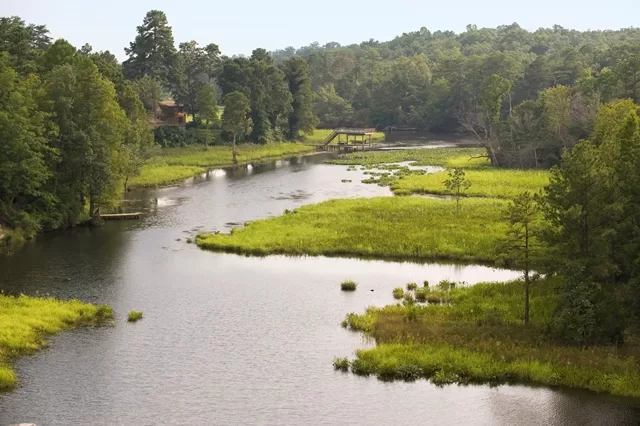Protecting our Waterways and Wetlands: James City County’s Stormwater and Resource Protection Division
If you enjoy all the wonders our waterways and wetlands in James City County offer, we have great news to share. By implementing simple best practices, you can protect your view, preserve your yard, safeguard wildlife, and help improve local water quality. In this article, we will explore the significance of the County’s Chesapeake Bay Preservation Ordinance (CBPO), a set of regulations that apply to all properties in James City County, and the steps you can take to be a responsible waterway steward.
The Importance of the Chesapeake Bay:
The Chesapeake Bay is an invaluable national treasure, renowned as the largest estuary in the United States and one of the world’s most productive. Spanning across 64,000 square miles of land, the Bay is home to over 3,700 species of plants and animals. Every waterway connected to the Bay, including those in James City County, plays a crucial role in supporting and maintaining this delicate ecosystem.
Understanding the Chesapeake Bay Preservation Ordinance and the Role of RPAs and RMAs:
In James City County many properties are subject to the regulations of the Chesapeake Bay Preservation Act, as adopted by the County under the Chesapeake Bay Preservation Ordinance (CBPO). These regulations are based on the proximity of the property to waterways or wetlands. Your decisions regarding your property can significantly impact water quality and habitats within James City County.
Resource Protection Areas (RPAs) and Resource Management Areas (RMAs) are pivotal in preserving the natural environment of James City County’s waterways. These designated zones ensure responsible land use and development practices. The entire county serves as an RMA, meaning that every inch is deserving of protection, responsible land use, and conscientious development practices throughout.
RPAs are those areas including tidal wetlands, tidal shores, certain nontidal wetlands, and land adjacent to water bodies with perennial flow. Also included in the RPA are 100-foot buffers that encompass trees, shrubs, and plants. These buffers play a vital role in protecting sensitive areas against erosion and enhancing water quality by filtering pollutants from stormwater runoff. Tidal wetlands, whether vegetated or not, are regions where land meets water, subjected to periodic inundation with changing tides. Looking after the critical zones that are RPAs and their buffers is our collective responsibility.
Navigating CBPO Regulations:
For more than 30 years, James City County’s CBPO has mandated a balance between property development and water quality. If you are considering any changes or improvements to your property, even those as minor as installing a patio or adding a fence, your actions may be subject to CBPO regulations. To help homeowners determine their property’s compliance with these rules, James City County provides a valuable resource—the JCC Property Information System website. This user-friendly tool grants free access to GIS map layers, including the Resource Protection Area (RPA) layer and a Conservation Easement layer. By utilizing this website, you can determine whether your property lies within the RPA or if you are in proximity to a conservation easement.
If your property falls within the buffer area or if you have any questions about obtaining approval for work on your property, please reach out to the Stormwater and Resource Protection (SRP) Division for information and guidance. They will ensure that you make informed and approved decisions. Contact information for SRP staff, as well as a link to the JCC Property Information System can be found at the end of this article.
Best Practices for Waterway Stewardship:
To become an effective waterway steward and preserve the health of your waterfront property in James City County, here are some recommendations to consider:
- Check if your project falls within the RPA buffer by contacting County staff or utilizing the JCC Property Information site.
- Embrace the concept of “Don’t mow, let it grow” for lawns near the water, as this approach helps protect water quality in James City County.
- Preserve existing trees and plants in your yard, as they act as natural filters for pollutants and help prevent erosion.
- Consider replacing grassy lawns with perennial native plants, using James City County’s handy Native Plant Guide as a resource (see link below).
- Seek guidance and assistance from SRP staff and/or a qualified consultant to ensure that your plans align with waterway conservation principles.
Conclusion
The trees, shrubs, and other vegetation along our shorelines play a pivotal role in maintaining the cleanliness of James City County waterways. It is essential to be aware of the local approval requirements for home and yard improvements. By adhering to the CBPO regulations and embracing responsible practices specific to James City County, you can contribute to the preservation of sensitive areas, even on private property. Remember to contact SRP staff to determine if your property is subject to CBPO regulations and to seek their approval before undertaking any future projects. Let us all work together to protect and preserve the beauty of our waterways and the Chesapeake Bay for future generations in James City County.
Useful Links and Contact Information:
JCC Property Information System website
https://property.jamescitycountyva.gov/JamesCity/
https://jamescitycountyva.gov/DocumentCenter/View/2162/Native-Plant-List-PDF
Stormwater and Resource Protection Division
Phone: 757-253-6670
Email: [email protected]
Many thanks to the James City County Stormwater and Resource Protection staff for providing this article and photos of waterways within James City County.







